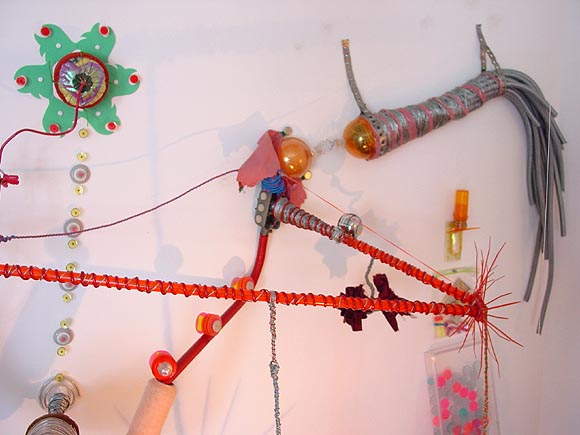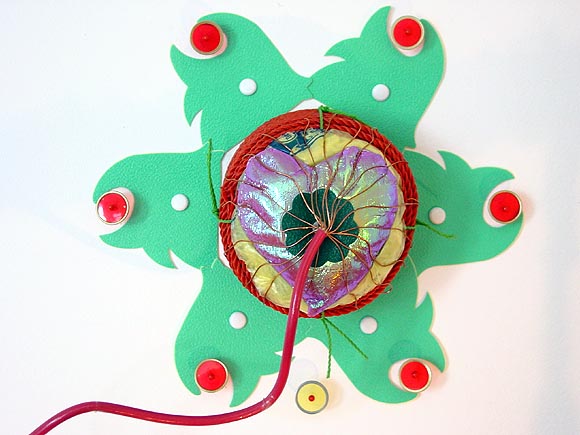View current page
...more recent posts
Guy Colwell is a Bay Area underground comix artist turned mural painter who recently went back to explicit political work, to disastrous effect. As described in this Steve Gillliard post (and original story), Colwell tackled the Abu Ghraib prison torture story and his painting was so effective it got his art dealer literally punched in the face, and spat on, by angry yahoos. The gallery--in the bohemian North Beach area of San Francisco, of all places--was also vandalized, and the dealer closed her business yesterday. The painting is explicit, illustrational agitprop in the Sue Coe tradition, depicting subhuman GIs with American flag patches on their uniforms, screaming in rage at a row of naked figures, hooded, wired up and standing on buckets. All the emotions are right up on the surface, and this is a time when emotions matter.
Colwell has taken the Abu Ghraib photos, which were already starting to lose some shock value through endless media repetition, and dared to nationalize them by making ugly, monstrous caricatures out of "the troops." We aren't supposed to regard our soldiers as bad or suspect, even though the war was launched for fraudulent reasons and no one knew how the "liberated" Iraqis were being treated. (For the record, I support the troops but wish they could be put to work by the Pentagon protecting us from our real enemies.) The people who assaulted Colwell's dealer are still in whipped up "war mode"--which is hard to come down from after all the Fox News and New York Times/Judith Miller propaganda. The dark side of America is an ugly beast and with blood in the air, it's not so easy to calm. When the Japanese attack you, you put all your energy into attacking the Japanese; when an "invisible network of terror cells" attacks you, it's hard to know where the energy's supposed to go. So you hit "sitting duck" countries. And art dealers.
Fortunately there's some counter-energy in the form of concerned artists who fear fascism at home more than randomly-striking terrorists. In this sense Guy Colwell is a sort of anti-Mumford, referring here to Steve Mumford's rapidly-dating "Parisian flaneur in Iraq" sketchbook drawings of American soldiers at work and rest in an exotic foreign land. Those bland, tastefully smeared, courtroom style drawings, purporting to be some kind of art vérité, managed to hide the hatefulness and essential wrongness of the US invasion of a country that never threatened us except with words--a classic colonial adventure fused with misdirected payback. Mumford even got interviewed by CNN, the official voice and supporter of the war. Colwell's art is simplistic, not tasteful in the least, but it cuts right to the subjugating core of the BushCo enterprise. Not that a punch in the face validates art or is anything other than repugnant, but no one will ever be punched over Mumford's drawings.
[UPDATE: Capobianco gallery's "Guy Colwell page," which had a clearer view of the Abu Ghraib painting, was removed a few hours after I posted this (that's the gallery where the dealer was attacked). Its website is now also closed, but has a phone number to view a video of the gallery closing memorial.]

Details from an installation by John Parker at The Front Room, Williamsburg, Brooklyn. The compacted, obsessively joined household materials somewhat recall Sarah Sze's early work but with more of a playful, Digimon vibe. I actually prefer Parker's sense of geometric pattern and general all-around oddness using twisty ties, wire, tape, wood screws, electrical hardware, light bulbs, plastic bags, etc. Other artists working in the "geometric assemblage" vein include Lucky de Bellevue and the British artist Daniel Coombs, excellently documented on James Hyde's site. Last day for the Parker show is tomorrow, Sunday, May 30. Gallery info is here. More of my installation pics are here. Parker is also a musician; my review of a recent show of his playing with The Man From Planet Risk is here.

Lynn Cazabon at Schroeder Romero, Williamsburg, Brooklyn. This very painterly looking image is actually a photograph, and the subject of the photo is a film. What you are looking at is a long strip of film that has been unspooled from its canister and arranged in looping, floral patterns, then photographed edge-on. The large digital photoprint is mounted as if it were a projector screen. Other works in the show are done similarly; all are (16mm?) films recently discarded or de-accessioned from a public collection (the Pratt Library in Baltimore). I kind of hate Cazabon's implication that "pretty, formal work" is what you do with a dead or rapidly-becoming-obsolete medium--in other words, make intricate filigrees for what she calls film's "casket" or "memento mori." Pretty patterns can also be vital, as we shall see in the next post. Another thing this work perversely brought to mind was the old Echoplex analog tape delay, which had a similar (if not as baroque) looping of tape inside its guts, to make cool spaced-out sounds back in the 60s and 70s. That's obsolete, too, but fondly remembered, as this google search page shows. [hat tip to bloggy for reminding me to see the Cazabon show]

